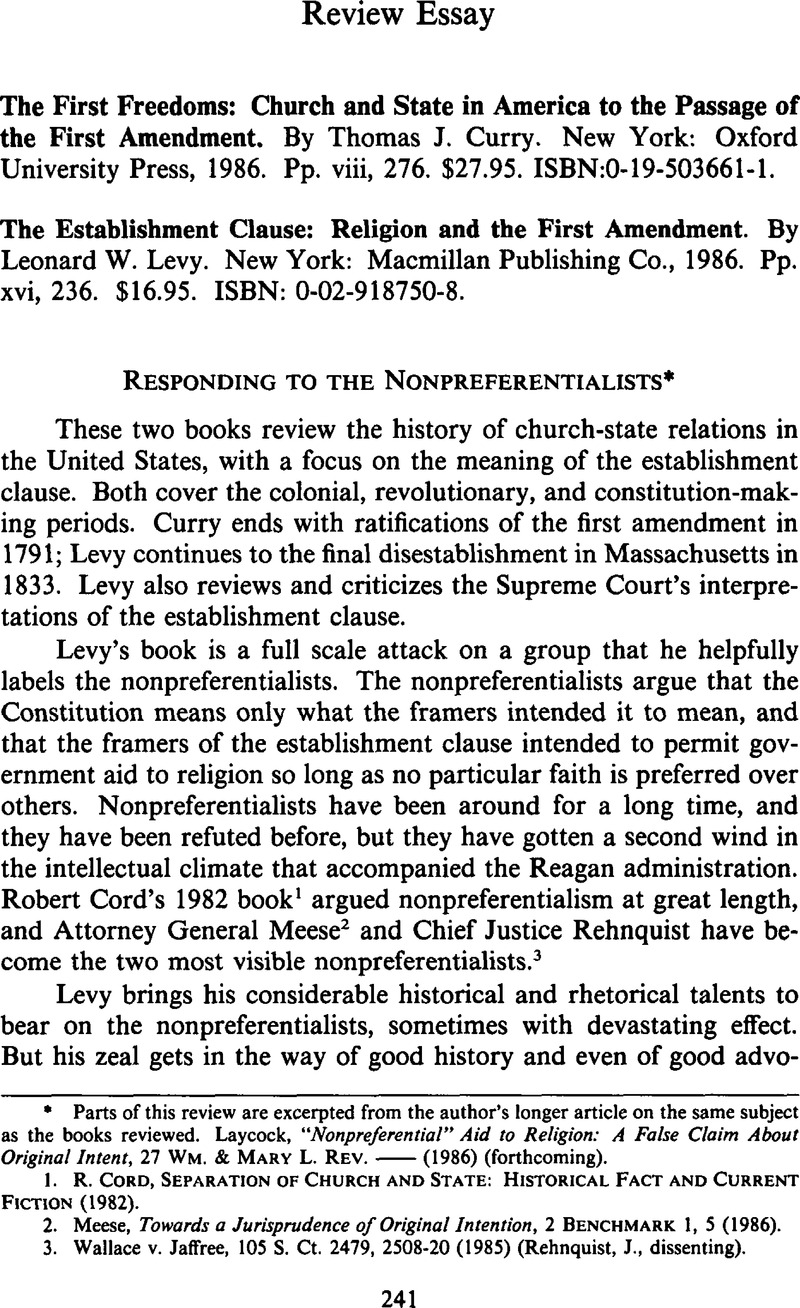No CrossRef data available.
Published online by Cambridge University Press: 24 April 2015

Parts of this review are excerpted from the author's longer article on the same subject as the books reviewed. Laycock, “Nonpreferential” Aid to Religion: A False Claim About Original Intent, 27 Wm. & Mary L. Rev.——(1986) (forthcoming).
1. Cord, R., Separation of Church and State: Historical Fact and Current Fiction (1982)Google Scholar.
2. Meese, , Towards a Jurisprudence of Original Intention, 2 Benchmark 1, 5 (1986)Google Scholar.
3. Wallace v. Jaffree, 105 S. Ct. 2479, 2508-20 (1985) (Rehnquist, J., dissenting).
4. A Bill Establishing a Provision for Teachers of the Christian Religion, reprinted in Everson v. Board of Educ, 330 U.S. 1, 7274 (1947) (Appendix to opinion of Rutledge, J., dissenting).
5. This legislative history is reviewed in more detail in part II.A of my forthcoming article, “Nonpreferential” Aid to Religion: A False Claim About Original Intent, 27 Wm. & Mary L. Rev.——(1986)Google Scholar.
6. The provision is reprinted in Buckley, T., Church and State in Revolutionary Virginia, 1776-1787 35 (1977) [hereinafter Buckley]Google Scholar, and in 1 Stokes, A., Church and State in the United States 305 (1950)Google Scholar.
7. Kurland, , The Origins of the Religion Clauses of the Constitution, 27 Wm. & Mary L. Rev. ——(1986) (forthcoming)Google Scholar. Virginia opponents of financial aid to churches saw free exercise and disestablishment as inextricably linked. See Buckley, supra note 6, at 18-19, 22.
8. ¶9; see also ¶¶ 6 and 8. The Memorial and Remonstrance has been reprinted widely. Everson v. Board of Education, 330 U.S. 1, 63-72 (1947) (Appendix to opinion of Rutledge, J., dissenting); R. Cord, supra note 1, at 244-49; Padover, S., The Complete Madison: His Basic Writings 299–306 (1953)Google Scholar.
9. ¶16 (1776), 9 Hening's Statutes at Large 109, 111-23 (1821). The provision is quoted in T. Buckley, supra note 6, at 19, and in 1 A. Stokes, supra note 6, at 303.
10. The pro-assessment petitions are summarized in Buckley, supra note 6, at 113-43.
11. See Ely, J., Democracy and Distrust: A Theory of Judicial Review 36 (1980)Google Scholar.
12. See 10 The Papers of Alexander Hamilton 302–04 (Syrett, H. & Cooke, J. eds. 1966)Google Scholar; see also United States v. Butler, 297 U.S. 1, 64-67 (1936).
13. 1 Annals of Cong. 449-50, 455-56 (June 8, 1789). The pagination is different in some printings.
14. Id. at 758 (Aug. 15, 1789). For an analysis of Huntington's remarks, see part II.B of my forthcoming article, supra note 5.
15. This attention to the merits when debating details coexisted with a willingness to support or oppose the whole Bill of Rights for the collateral purpose of increasing or reducing public support for the new Constitution. See Levy, pp. 87, 108-09.
16. See supra notes 11-13.
17. However characterized, this establishment was abolished in 1777 (Levy, p. 26)
18. Such a claim appears in O'Neill, J., Religion and Education Under the Constitution 204 (1949) (quoted in Levy, p. 6)Google Scholar.
19. At one point he concedes that the establishment in Connecticut was preferential in fact, though not in theory (p. 41). At another point, he says the Connecticut establishment was nonpreferential (p. 22).
20. “Such an establishment can hardly be called an exclusive or preferential one, as in the case where only one church, as in the European precedents, was the beneficiary.” (p. 62).
21. Commentators on Levy's work on freedom of speech and press have criticized a similar emphasis on the legal theory of seditious libel instead of the practical reality of a free press. See, e.g., Anderson, , Levy vs. Levy (Book Review), 84 Mich. L. Rev. 777 (1986)CrossRefGoogle Scholar; Anderson, , The Origins of the Press Clause, 30 Ucla L. Rev. 455, 509–15 (1983)Google Scholar; Jensen, , Book Review, 75 Harv. L. Rev. 456, 456–57 (1961)CrossRefGoogle Scholar. For Levy's response, conceding the validity of the criticism but only in part, see Levy, L., Emergence of a Free Press (1985)Google Scholar; Levy, , The Legacy Reexamined, 37 Stan. L. Rev. 767, 767–70 (1985)CrossRefGoogle Scholar.